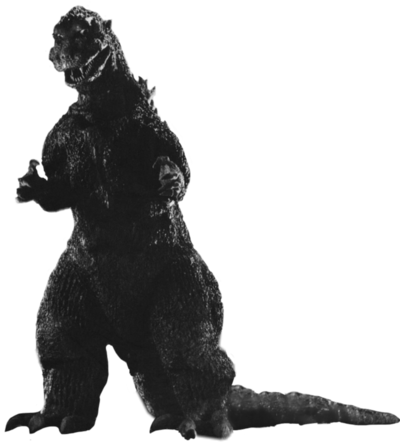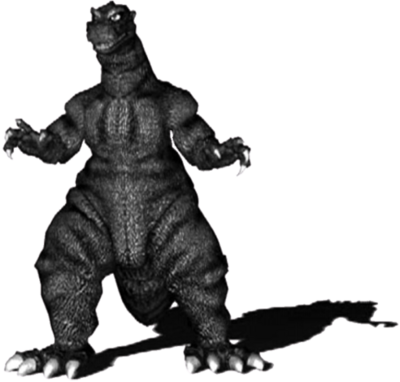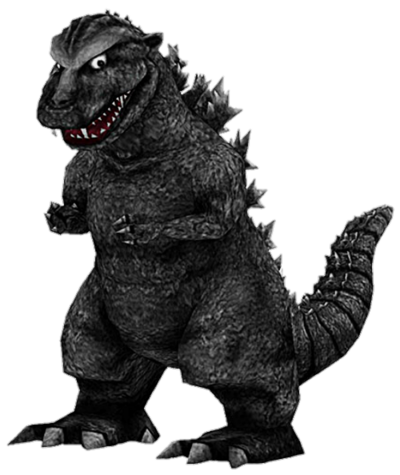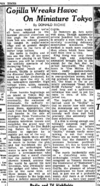
| “ | This creature, according to the folklore of Ohto Island, is called Godzilla. | „ |
| ~ Kyohei Yamane on Godzilla |
The official discord link if you wish to join the discord: https://discord.gg/j5RKwCvAFu
Support the wiki on our official Ko-Fi page or Patreon page!
Articles About Godzilla
| |
|---|---|
| Generations | First Godzilla - Second Godzilla - Heisei Era - TriStar Era - Kiryu Series - Monsterverse |
| Other Continuity Movies | Millennium - Godzilla vs. Megaguirus - Godzilla, Mothra and King Ghidorah: Giant Monsters All-Out Attack - Final Wars - Shin Godzilla - Godzilla vs. Gigan Rex - Godzilla Minus One |
| Other Continuity TV Series | Godzilla: The Series - Godzilla Singular Point - Chibi Godzilla Raids Again - Pucca Funny Love |
| GODZILLA: Planet of the Monsters | Godzilla Filius - Godzilla Earth |
| Comics | Marvel Domics - DC Comics - Dark Hose Comics - IDW Comics - Godzilla In Hell |

| “ | This creature, according to the folklore of Ohto Island, is called Godzilla. | „ |
| ~ Kyohei Yamane on Godzilla |

| “ | The original king of the monsters, this towering behemoth was the first post-war radioactive monster unleashed upon the world. Godzilla '54's atomic-powered body was so powerful that each footprint he left was a crater seeping with lethal radiation. The infamous day that Godzilla rose from the sea to conquer Tokyo will be remembered as the beginning of the humanity's epic struggle against the reign of giant monsters. | „ |
| ~ Godzilla 1954 bio in Godzilla: Unleashed |

Godzilla (ゴジラ Gojira) is a kaiju who first appeared in the 1954 film Godzilla. The original Godzilla is a prehistoric amphibious sea creature that was disturbed and burned when an American hydrogen bomb test conducted in the Pacific Ocean destroyed his habitat and drew him to the surface. Godzilla unleashed his rage upon humanity, destroying any ships in his vicinity and eventually laying waste to Odo Island and the city of Tokyo. Daisuke Serizawa eventually used his invention, the Oxygen Destroyer, to kill Godzilla, while taking his own life to ensure the weapon could never be used again. Typically, in the various continuities of the Godzilla franchise, a second Godzilla appears sometime after this Godzilla's death. Despite only being the focus of one film, the First Generation Godzilla has been referenced to some degree in several entries in the series since.
| This dropdown contains the synopsis of Godzilla’s story. Read at your own risk as you may be spoiled otherwise! |
|---|
|
Showa Era In the aftermath of Godzilla's raid, Tokyo was an uninhabitable wasteland, burned to a crater and contaminated with deadly radiation. The Japanese government was at a loss in combating the monster and preventing future attacks. Scientist Daisuke Serizawa was approached by his former fiance Emiko Yamane and her boyfriend Hideto Ogata, who asked for him to use his experimental chemical weapon, the Oxygen Destroyer, against Godzilla. Serizawa was horrified by the idea of revealing his invention to the world and refused at first, but was convinced after watching a television program showing Japanese schoolchildren singing a song praying for peace. Serizawa burned his notes on the Oxygen Destroyer and handed it over to the JSDF. A boat was sent to Tokyo Bay, using a Geiger counter to locate Godzilla underwater. Serizawa and Ogata donned diving suits to go underwater and detonate the device. Once they reached Godzilla, who was sitting on the ocean floor, Ogata was pulled to the surface while Serizawa severed his line and activated the device, sacrificing his own life to stop Godzilla and prevent his weapon from ever falling into the wrong hands. After a few moments, Godzilla rose to the surface and roared defiantly at the boat before sinking under the waves to his death. While the people on the boat both celebrated Godzilla's demise and mourned Serizawa's sacrifice, Dr. Yamane solemnly warned that it was unlikely Godzilla was the last member of his species, and that if mankind continued nuclear testing, another Godzilla would almost certainly appear. Godzilla Raids Again
Heisei Era Godzilla vs. Destoroyah
|
Origin: Godzilla (1954)
Sex: Male (Godzilla is constantly referred to with "he/him" pronouns throughout the movie. Though it was speculated by producer Tomoyuki Tanaka that Godzilla could have been a female[2])
Age: At least 2 million years old (Theorized to have been alive at least since the Jurassic period by Professor Yamane[3])
Classification: Gojilla[4], Goji, ShodaiGoji, Original Godzilla, Godzilla 1954, First Generation Godzilla, Angurus[5], Godzilla-1st.[6], Giant Hydrogen Bomb Monster 水爆大怪獣 (Suibaku Daikaijū?)[7]
, King of the Monsters 怪獣王 (Kaijūō?)[8]
Species: Irradiated prehistoric amphibious reptile[9]
Occupation: None
Status: Deceased (Godzilla was eventually killed by the Oxygen Destroyer[10])
Alignment: Chaotic Neutral (Seeks vengeance on humanity for attacking and altering its natural habitat and home from the atomic bomb[11][12])
Tier: At least High 8-C, Far Higher with Absorption. Has a 7-C Power Source through radiation
Dimensionality: 3-D
Attack Potency: At least Large Building level (Directly noted to be 50 meters in height[13], along with being estimated to be this tall[14]. Destroyed many buildings and towers through tearing through them or swinging at them with his tail[15]. Upon waking up caused a massive explosion that sunk the Southern Sea Steamship Company vessel, the Eiko-maru, a 7500 ton freighter[16], sunk another freighter that tried to search for the Eiko-maru[17]), Far Higher with Absorption (Godzilla is able to absorb energy and get far stronger from it[18], such as him absorbing an enormous amount of radiation[19]). Has a Town level Power Source through radiation (Godzilla after being hit by the atomic bomb absorbed an enormous amount of atomic radiation[20], along with being noted how he was able to absorb a massive amount of atomic radiation[21]). Bypasses conventional durability with his Atomic Breath (Godzilla's breath can shoot out white vapor hot enough to melt metal[22], and cause fires across several city blocks[23], allowing him to bypass conventional durability through its extreme heat)
Durability: At least Large Building level (Took no damage from any tank fire[24]), Far Higher with Absorption (Godzilla after being hit by the atomic bomb absorbed an enormous amount of atomic radiation[25], along with being noted how he was able to absorb a massive amount of atomic radiation but still survived[26], noted by the professor how he is still alive despite how much radiation he absorbed[27])
Striking Strength: At least Large Building Class
Lifting Strength: Class M (Easily flipped over a giant bridge[28], with modern day Tokyo bridges weighing 36,000 tons. Easily ripped off buildings, clock towers, and bent the transmit tower[29]. Casually lifted and threw a giant metal tower[30])
Travel Speed: Superhuman (Through his sheer size and how far he is able to cross cities, he should move this fast)
Combat Speed: Superhuman
Reaction Speed: Superhuman
Stamina: Superhuman (Caused long attacks across Tokyo without tiring, only stopping his attack to retreat back underwater after the fighter jets attempted to attack him[31])
Range: Tens of Meters through sheer size (Directly noted to be 50 meters in height[32], , along with being estimated to be this tall[33]), Hundreds of Meters with Atomic Breath (Godzilla's breath can shoot out white vapor hot enough to melt metal[34], and cause fires across several city blocks[35])
Intelligence: Average (Godzilla is more aware then an average animal, knowing that humanity injured his family, destroyed his natural habitat, and irradiated him, with his response being to seek vengeance on them[36][37])
Superhuman Physical Characteristics, Natural Weaponry (Godzilla has shown to use his claws and tail to tear through many buildings and towers, along with his teeth to bend down the transmit tower[38]. His feet being able to easily crush objects such as houses[39]), Longevity (Theorized to have been alive at least since the Jurassic period by Professor Yamane[40]), Large Size (Building sized; Directly noted to be 50 meters in height[41], along with being estimated to be this tall[42]), Aquatic Breathing (As it has lived within the bottom of the ocean, it can breathe underwater[43]), Enhanced Senses (As it has lived within the bottom of the ocean, it is able to navigate within the dark waters[44] where there is rarely any significant light beyond 200 meters), Pierce Resistance (Standard Pierce Resistance; Conventional weaponry bounces off of his skin[45], took no damage from any tank fire[46]), Absorption (Godzilla after being hit by the atomic bomb absorbed an enormous amount of atomic radiation[47], noted by the professor how he is still alive despite how much radiation he absorbed[48]), Reactive Adaptation (Godzilla absorbing an enormous amount of atomic radiation allowed him to where he lived and mutated from it[49], a feat even noted by Professor Yamane[50]), Radiation Manipulation (Godzilla spread radiation across several wells on an island he walked past, making the water in the wells dangerous to touch or drink, along with his footprints being radioactive and dangerous to be near[51]. Noted that each footprint he leaves was a crater seeping with lethal radiation[52]), Sound Manipulation (Due to the mutation from his exposure to a hydrogen bomb radiation, Godzilla is able to produce extremely loud, ear-piercing roars[53]), Breath Attack, Smoke Manipulation, & Heat Manipulation (Godzilla's breath can shoot out white vapor hot enough to melt metal[54], and cause fires across several city blocks[55]), Light Manipulation (Godzilla can cause his skin to light up[56]).
Resistance to Radiation (Godzilla is noted how he was able to absorb a massive amount of atomic radiation but still survived[57], noted by the professor how he is still alive despite how much radiation he absorbed[58]), Oceanic Pressures (Has lived within the deep waters of the ocean, with no damage to its skin despite[59] the large amounts of pressure at the bottom of the ocean), Electricity (Took no damage from an electric current[60] that was 50,000 volts[61])
Nothing notable.
Standard Tactics: Godzilla will attack if angered or irritated, with Professor Yamane noting that things such as lights on him will only make him angry[63].
Weaknesses: Although his durability proved beyond humanity’s capabilities to harm him, Godzilla was eventually killed by the Oxygen Destroyer[64], a weapon that contained a chemical compound that liquefies oxygen atoms, causing living creatures to die of asphyxiation as their remains are liquefied by the surrounding water as it becomes corrosive[65].
0-1-0
None.
None.
